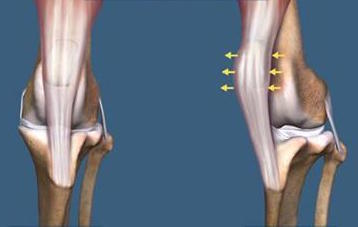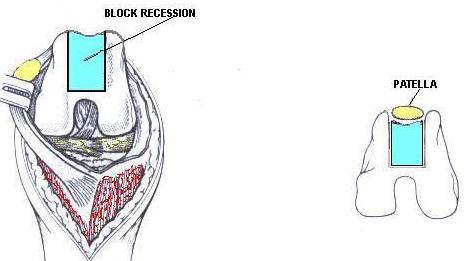What is patellar luxation?
The patella or “knee-cap” sits at the front of the knee within the quadriceps muscle and sides up and down within a groove. Patellar Luxation is when the knee cap slips out (dislocates) from the groove. This typically occurs secondary to malalignment of the quadriceps mechanism. Deformities in the hip, femur (thigh bone) and tibia (shin bone) typically contribute to poor alignment of the quadriceps muscle group "pulling" the patella out of position. These deformities develop early in life during the growth phase. The onset of patella luxation may occur at this time or not until much later following a traumatic event; soft tissues that have previously resisted the “pull” created by malalignment finally tear, allowing the patella to luxate i.e. an underlying problem was already present that predisposed to patellar luxation. Patellar luxation is painful and destabilises the knee, placing increased strain on other joint stabilisers including the cranial cruciate ligament (CCL). Chronic patella luxation is a risk factor for tearing of the CCL.

Diagrammatic representation of medial patellar luxation. The arrows show the patella moving out of the "groove" towards the inner side of the knee.
Treatment Options
Surgery is primarily aimed at improving overall alignment, although additional procedures are typically performed; these may include deepening the patella groove (performed if the existing groove is too shallow), tightening the outside of the knee joint (imbrication) and relieving tension on the inside of the knee joint (releasing incision) for medial patella luxation, or the reverse for lateral luxation. Surgery to improve alignment at the level of the attachment of the patella tendon on the tibia with a tibial tuberosity transposition will be sufficient to stop the patella luxating in most cases; however, sometimes the patella will continue to luxate despite these initial corrections. This is not unexpected given the complexity of the deformities from the hip to the knee that contribute to patellar luxation and the relatively simple alignment adjustment that is typically used to manage this condition. In cases of persistent luxation, further surgery to correct deformities of the distal femur and/or at the level of the hip may be necessary.
Patellar luxation destabilises the knee resulting in increased strain on other joint stabilisers including the cranial cruciate ligament (CCL). Chronic patella luxation is a risk factor for tearing of the CCL. The cranial cruciate ligament will be assessed during exploration of the knee joint (patellar luxation increases strain on CCL). If tearing of the CCL is identified additional surgical procedures are typically necessary (e.g. TPLO, IPLS).
The majority of dogs progress uneventfully following surgery to correct patella luxation and are eventually able to return to their normal activities. Many dogs improve significantly within the first month following surgery; nevertheless, it may take a number of months before a dog has fully recovered. Dogs with chronic knee problems and especially those with substantial muscle atrophy will be expected to progress more slowly, as will dogs that have had previous surgery.

Diagrammatic representation of a rectangular block recession trochleoplasty
Outcome and potential risks of surgery
Most dogs progress uneventfully following surgery to correct patella luxation and are eventually able to return to their normal activities. Many dogs improve significantly within the first month following surgery; nevertheless, it may take a number of months before a dog has fully recovered. Dogs with chronic knee problems and especially those with substantial muscle atrophy and/or dogs that have had previous surgery will progress more slowly.
As with any surgery, complications may arise as detailed below, although serious complications are uncommon.
-
Infection is an uncommon complication as strict sterile technique is used during the surgery and antibiotics are administered during and potentially after the procedure. Should an infection occur, early detection and treatment often result in rapid resolution, although sometimes removal of the implants may be required once the bone has healed. More serious problems may occur if the infection progresses untreated or if your dog suffers an infection that is resistant to multiple antibiotics e.g., MRSA.
-
Excessive early activity may increase the risk of loosening or breakage of pins, wires and screws and/or fracture of the tibial tuberosity or trochlea, which may necessitate further surgery.
-
Even after the bone has healed it is still important to have a controlled, gradual increase in activity, similar to human patients undergoing rehabilitation following knee surgery. If activity in dogs is increased too quickly after surgery straining of the patellar ligament or other joint structures can occur. Rest and anti-inflammatory medications typically resolve these problems.
-
Repeated patella luxation gradually wears away the cartilage on the underside of the patella. This damage is permanent and cannot be undone; i.e. any damage preset at surgery is irreversible. In cases of severe wear, the underlying bone may be exposed which can be a source of chronic pain. This is why it is important to address recurring patella luxation as soon as reasonably possible.
-
Arthritis is usually present at the time of surgery and will progress to some degree regardless of treatment. In cases of chronic patella luxation significant joint injury may have occurred and arthritis is typically more advanced. Previous knee surgery is also often associated with a more rapid progression of arthritis. Unfortunately, it is not possible to reverse the arthritic changes in the joint or undo other damage already done, but the surgery will stabilise the knee thereby reducing inflammation, which may help to reduce the ongoing progression of arthritis.
-
Persistence or recurrence of patella luxation may occur, including luxation in the opposite direction. Persistence or recurrence of patellar luxation is the most common complication after surgery; as previously mentioned quadriceps malalignment involves deformities of the hip, femur and tibia, and whilst improving alignment at the level of the tibia will often be sufficient to resolve patella luxation it is not addressing all deformities present. When patellar luxation persists or recurs additional surgery is indicated; this may involve further alteration of alignment at the level of the tibia, additional soft tissue procedures e.g. transposition of muscle attachments, and correction of femoral deformities.
Aftercare Of Your Dog Following Knee Surgery:
Your dog should be kept confined to eliminate running and jumping for at least the first 4 to 6 weeks: a single room with non-slip flooring and no furniture may be sufficient, however, a large cage may be necessary. Short leash walks in the garden (a few minutes four to six times daily) are recommended initially to allow toileting.
Two to three weeks following surgery lead walking may commence, provided limb function has significantly improved post-surgery. Walk slowly for 5 minutes at a time, two to three times daily, but maintain confinement at other times. Lead walking may gradually increase but should not exceed 10 minutes at a time, three times daily for the first six weeks following surgery.
Hydrotherapy is beneficial (but not essential) to recovery but should only be performed in a centre with qualified personnel. Hydrotherapy may commence at two to four weeks post surgery in a water treadmill, or at four to six weeks following surgery in a swimming pool. Any activities prior to confirmed healing of bone will introduce risks e.g. car travel to and from hydrotherapy, slipping/falling.
X-rays are typically taken four to six weeks following surgery to assess implants and bone healing.
